What is Page Load Time in Performance Testing?
As per the definition of response time in the performance testing, ‘Response Time refers to the amount of time from the moment that a user sends a request until the time that the application indicates that the request has completed and reaches back to the user.’ But, nowadays a new term is getting added in the performance testing which is ‘Page Load Time’. Page Load Time represents the amount of time it takes for a page to show up on your screen. Also, we can say that it is a time when all the components (items) of a page get displayed on the browser for user interaction. It depends on 3 things:
- Server Processing Time: How quickly the servers serve the request and send response back to the client.
- Network Latency: How quickly the communication channel transfer the information from client to server and server to client.
- Component Load Time: How quickly it takes for the browser to parse and execute the document (available in cache or coming from server) and render the page to make it available for user interaction.
Let’s try to understand the terms with the given figure:

- User enters a URL, submits a form, or clicks on a hyperlink
- Browser makes a request to the server through the network
- Server processes the request
- Server sends the response back to the browser
- At client end, browser starts receiving the requested page and related information
- Browser fetches the stored cache components
- Browser parses, loads, and renders the page content
- The entire requested page becomes available on the browser
How to improve it?
Following are the common methods to improve the Page Load Time:
- Reduces the size of the CSS, HTML, JavaScript, images, and other web elements
- Optimizes the code by removing unused code, white spaces, comments, etc.
- Reduce the redirects
- Fast Network
You may be interested:

